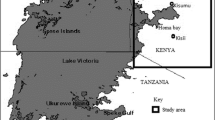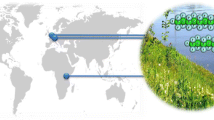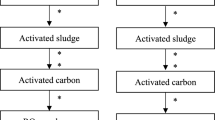Abstract
Purpose
Perfluorooctanoate (PFOA), perfluorooctane sulfonate (PFOS), and precursors and derivatives thereof have been employed as surfactants and anti-adhesives. PFOA and PFOS are environmentally persistent and the discharge of municipal waste waters is one of the principal routes of these compounds into the aquatic environment. In a previous study, the concentrations of PFOA and PFOS in grab samples collected from the waste water treatment plant (WWTP) of Bayreuth, a city of 72,000 inhabitants in Bavaria, Germany, during two periods showed considerable variability. For a better estimate of average mass flows, the surfactants were monitored (five samplings) from 16 March to 18 May 2007. In a second campaign, river water receiving the WWTP effluent was sampled twice a day for five consecutive days.
Methods
Quantitative analysis was done by stable-isotope dilution, pre-cleaning, and pre-concentration by solid-phase extraction, and liquid chromatography followed by electrospray ionization/tandem mass spectrometry.
Results
The mass flows of PFOA and PFOS through the WWTP were determined. PFOA is fully discharged into the river, while about half of PFOS is retained in the sewage sludge. The average daily mass load of the river Roter Main by the WWTP of Bayreuth is about 1.2 ± 0.5 g PFOA and 5 ± 2 g PFOS, with variations of up to 140% within one day.
Conclusion
Overall, the total annual release to the rivers of Germany may be in the range of several hundred kilograms of PFOA and several tons of PFOS.


Similar content being viewed by others
References
Becker AM, Gerstmann S, Frank H (2008) Perfluorooctane surfactants in waste waters, the major source of river pollution. Chemosphere 72:115–121
Boulanger B, Vargo JD, Schnoor JL, Hornbuckle KC (2005) Evaluation of perfluorooctane surfactants in wastewater treatment system and in a commercial surface protection product. Environ Sci Technol 39:5524–5530
Corinna H (2006) Greenpeace e.V., Press release published online 9/2006 http://www.greenpeace.de/fileadmin/gpd/user_upload/themen/umweltgifte/greenpeace_chemie_im_aal.pdf
Dinglasan M, Ye Y, Edwards E, Mabury S (2004) Fluorotelomer alcohol yields poly and perfluorinated acids. Environ Sci Technol 38:2857–2664
Dreyer A, Weinberg I, Temme C, Ebinghaus R (2009) Polyfluorinated compounds in the atmosphere of the atlantic and southern oceans: evidence for a global distribution. Environ Sci Technol 43:6507–6514
Hansen KJ, Johnson HO, Eldridge JS, Butenhoff JL, Dick LA (2002) Quantitative characterization of trace levels of PFOS and PFOA in the Tennessee River. Environ Sci Technol 36:3316–3321
Huset CA, Chiaia AC, Barofsky DF, Jonkers N, Kohler HPE, Ort C, Giger W, Field J (2008) Occurrence and mass flows of fluorochemicals in the Glatt Valley Watershed, Switzerland. Environ Sci Technol 42:6369–6377
Kannan K, Tao L, Sinclair E, Pastva SD, Jude DJ, Giesy JP (2005) Perfluorinated compounds in aquatic organisms of various trophic levels in Great Lakes food chain. Arch Environ Contam Toxicol 48:559–566
Kissa E (2001) Fluorinated surfactants and repellents. Marcel Dekker, New York
Lange C (2001) The 18-day aerobic biodegradation study of perfluorooctanesulfonyl-based chemistries; 3M, Docket AR-226-E01-0415. U.S. Environmental Protection Agency, Washington, DC
Loganathan BG, Sajwan KS, Sinclair E, Kumar KS, Kannan K (2007) Perfluoroalkyl sulfonates and perfluorocarboxylates in two wastewater treatment facilities in Kentucky and Georgia. Water Res 41:4611–4620
Loos R, Locoro G, Hubner T, Wollgast J, Christoph EH, de Jager A, Gawlik BM, Hanke G, Umlauf G, Zaldivar JM (2008) Analysis of perfluorooctanoate (PFOA)and other perfluorinated compounds (PFCs) in the River Po watershed in N-Italy. Chemosphere 71:306–313
Loos R, Gawlik BM, Locoro G, Rimaviciute E, Contini S, Bidoglio G (2009) EU-wide survey of organic persistent pollutants in European river waters. Environ Poll 157:561–568
McLachlan ME, Holmstrom KE, Reth M, Berger U (2007) Riverine discharge of perfluorinated carboxylates from the European continent. Environ Sci Technol 41:7260–7265
Murakami M, Imamura E, Shinohara H, Kiri K, Muramatsu Y, Harada A, Takada H (2008) Occurence and sources of perfluorinated surfactants in rivers in Japan. Environ Sci Technol 42:6566–6572
Prevedouros K, Cousins JT, Buck RC, Korzeniowski SH (2006) Sources fate and transport of perfluorocarboxylates. Environ Sci Technol 40:32–44
Saito N, Sasaki K, Nakatome K, Harada K, Yoshinaga T, Koizumi A (2003) Perfluorooctane sulfonate concentrations in surface water in Japan. Arch Environ Contam Toxicol 45:149–158
Schultz MM, Barofsky DF, Field JA (2006a) a): Quantitative determination of fluorinated alkyl substances by large-volume-injection liquid chromatography tandem mass spectrometry—characterization of municipal wastewaters. Environ Sci Technol 40:289–295
Schultz MM, Higgins CP, Huset CA, Luthy RG, Barofsky DF, Field JA (2006b) b): Fluorochemical mass flow in a municipal wastewater treatment facility. Environ Sci Technol 40:7350–7357
Sinclair E, Kannan K (2006) Mass loading and fate of perfluoroalkyl surfactants in wastewater treatment plants. Environ Sci Technol 40:1408–1414
Sinclair E, Mayack DT, Roblee K, Yamashita N, Kannan K (2006) Perfluorinated compounds in aquatic organisms at various trophic levels in a Great Lakes food chain. Arch Environ Contam Toxicol 50:398–410
Skutlarek D, Exner M, Färber H (2006) Perfluorinated surfactants (PS) in surface and drinking waters. Environ Sci Pollut Res 13:299–307
So MK, Miyake WY, Yeung WY, Ho YM, Taniyasu S, Rostkowski P, Yamashita N, Zhou BS, Shi XJ, Wang JX, Giesy JP, Yu H, Lam PKS (2007) Perfluorinated compounds in the Pearl River and Yangtze River of China. Chemosphere 68:2085–2095
Weremiuk AM, Gerstmann S, Frank H (2006) Quantitative determination of perfluorinated surfactants in water by LC-ESI-MS/MS. J Sep Sci 29:2251–2255
Acknowledgments
We would like to acknowledge Bayerische Forschungsstiftung for financial support. We thank the Bureau of Water Management of Hof and employees of WWTP of Bayreuth for their cooperation.
Author information
Authors and Affiliations
Corresponding author
Additional information
This paper is dedicated to Otto Hutzinger on the occasion of his 75th birthday.
Rights and permissions
About this article
Cite this article
Becker, A.M., Suchan, M., Gerstmann, S. et al. Perfluorooctanoic acid and perfluorooctane sulfonate released from a waste water treatment plant in Bavaria, Germany. Environ Sci Pollut Res 17, 1502–1507 (2010). https://doi.org/10.1007/s11356-010-0335-x
Received:
Accepted:
Published:
Issue Date:
DOI: https://doi.org/10.1007/s11356-010-0335-x




